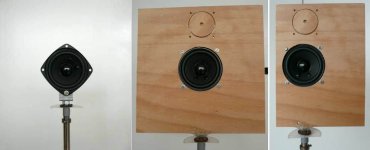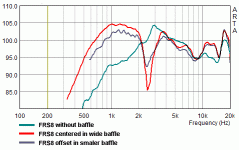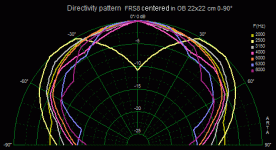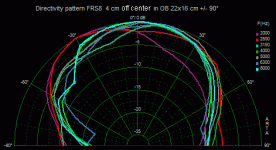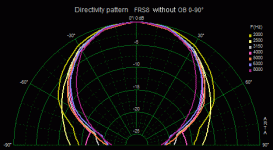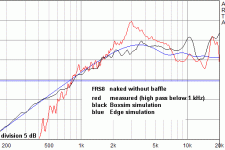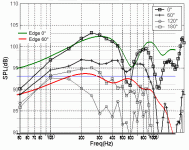Hi,
you can also try this, for simulation of OBs
http://www.tolvan.com/edge/help.htm
This is also a "recommended page":
http://www.dipolplus.de/
Kind Regards
you can also try this, for simulation of OBs
http://www.tolvan.com/edge/help.htm
This is also a "recommended page":
http://www.dipolplus.de/
Kind Regards
the open baffle is a common trap for even some veterans, looks simple enough - How hard can it be?!
Depends what you are after. OB is simple, but do you want a generic OB or a true dipole? That is, are you just interested in getting rid of the box or are you trying to control directivity? Doing a dipole right is very different than just OB.
Also Quarter Wavelength Loudspeaker Design
Very generally speaking, the science is to match the baffle step or H frame quarter wave resonance with the crossover slope in the LP crossover for an octave or so. Thus you get deep bass at levels that are audible such as -10 db, -6 db an so on. That way some efficiency is wasted, but for a good cause.
Combined science and practice say that there is no such beast as a full range on OB alone although with use of proper signal processing and/or passive elements IN theory it is possible to get 20-20 flat response from a single driver.
And when I say "some efficiency is wasted" in the first paragraph, I really mean wasted efficiency, such as an 18 inch bass driver operating with no more than 88 db@1w...
So you can't just do it, but it is not impossible at all!
I like it, because the design forces you to do allot of trade offs, thinking and combining, but it is within the normal man's powers.
Read Quarter Wave, there you can find several ready projects and you can obtain tools for designing any OB speaker.
Best regards.
Very generally speaking, the science is to match the baffle step or H frame quarter wave resonance with the crossover slope in the LP crossover for an octave or so. Thus you get deep bass at levels that are audible such as -10 db, -6 db an so on. That way some efficiency is wasted, but for a good cause.
Combined science and practice say that there is no such beast as a full range on OB alone although with use of proper signal processing and/or passive elements IN theory it is possible to get 20-20 flat response from a single driver.
And when I say "some efficiency is wasted" in the first paragraph, I really mean wasted efficiency, such as an 18 inch bass driver operating with no more than 88 db@1w...
So you can't just do it, but it is not impossible at all!
I like it, because the design forces you to do allot of trade offs, thinking and combining, but it is within the normal man's powers.
Read Quarter Wave, there you can find several ready projects and you can obtain tools for designing any OB speaker.
Best regards.
Science starts, when you look around.
Have a look at these different approaches:

You see a Visaton 3" fullrange driver FRS 8 "naked", centered in a 22x22 cm baffle and offset in a narrower baffle.
These are the according on-axis-responses:

It looks obvious to start with the offset driver - the one with the best correctable response. But look at its horrible polar pattern:
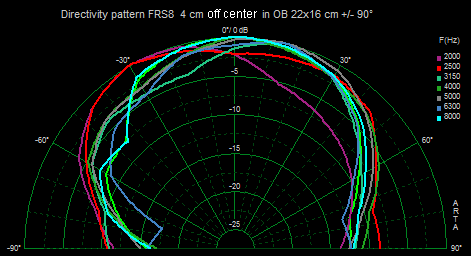
It faintly resembles the forward part of a dipole-8, but in a distorted disorder.
Trying the center-baffle instead?
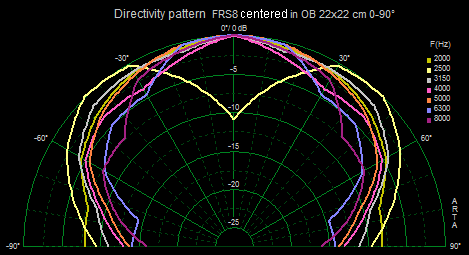
Better, but with a big hole on axis, which obviously can't be corrected.
Now let's move to the bare driver, which needs at least a 7 dB boost at 1 kHz:
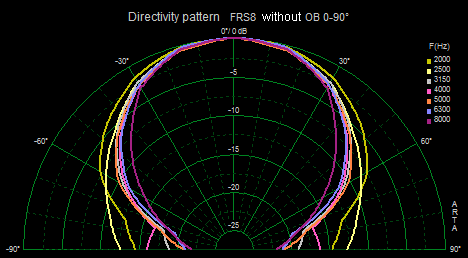
This finally looks like a decent figure-8.
I have tried to explain, what happens in between. You may look at dipolplus and download my "How open baffles work" pdf.
Have a look at these different approaches:
You see a Visaton 3" fullrange driver FRS 8 "naked", centered in a 22x22 cm baffle and offset in a narrower baffle.
These are the according on-axis-responses:
It looks obvious to start with the offset driver - the one with the best correctable response. But look at its horrible polar pattern:
It faintly resembles the forward part of a dipole-8, but in a distorted disorder.
Trying the center-baffle instead?
Better, but with a big hole on axis, which obviously can't be corrected.
Now let's move to the bare driver, which needs at least a 7 dB boost at 1 kHz:
This finally looks like a decent figure-8.
I have tried to explain, what happens in between. You may look at dipolplus and download my "How open baffles work" pdf.
Attachments
No, the hole does not fill in. What Stereophile probably did (they did it with the Jamo 907 in 2009) was a "spatially averaged" measurement. That means, they added off-axis measurements.but the hole fills in sitting >6' away from the baffle.
Stereophile mentioned this (measured it) when testing the smaller Jamo's last year.
This emphazises that one should design a dipole not for the 0° axis, but for a somewhat outside direction.
The naked driver needs to be EQed in EVERY case. Otherwise it HAS to sound weird.While the naked driver may have a better polar pattern, it simply sounds weird to me. Very unnatural and off color.
I should not have written "at least a 7 dB boost". What you in fact do is to cut off the +6 dB dipole peak between 1.5 and 8 kHz (which originates from the rear radiation adding constructively to the front radiation). So there is really no "boost" to speak of. My faultIt also needs tremendous amounts of EQ. 7 db at 1 kHz is a lot.
HOw does one arrive on the right design dimensions for an OB. Is there a science to it?
If the goal is to have smooth on and off-axis response, then the baffle width should be < 2*driver diameter. It is simply physics of amplitude and phase subtraction/addition.
Here you can immediately see the problem with jamo 909 midrange. Stereophile is totally clueless in explaining symptoms in their measurements.
But only for rough estimates and better not beyond 15° off axis. Look at the comparisons between simulations and measurements below:I recomend edge for experimenting with baffle shapes and driver shapes.
Attachments
- Status
- This old topic is closed. If you want to reopen this topic, contact a moderator using the "Report Post" button.
- Home
- Loudspeakers
- Multi-Way
- OB any science to it?
